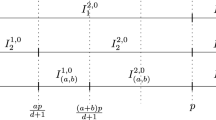Abstract
We study the frog model on homogeneous trees, a discrete time system of simple symmetric random walks whose description is as follows. There are active and inactive particles living on the vertices. Each active particle performs a simple symmetric random walk having a geometrically distributed random lifetime with parameter (1 − p). When an active particle hits an inactive particle, the latter becomes active. We obtain an improved upper bound for the critical parameter for having indefinite survival of active particles, in the case of one-particle-per-vertex initial configuration. The main tool is to construct a class of branching processes which are dominated by the frog model and analyze their supercritical behavior. This approach allows us also to present an upper bound for the critical probability in the case of random initial configuration.
Similar content being viewed by others
References
O.S.M. Alves F.P. Machado S. Popov K. Ravishankar (2001) ArticleTitleThe shape theorem for the frog model with random initial configuration Markov Process Relat. Fields 7 IssueID4 525–539
O.S.M. Alves F.P. Machado S. Popov (2002) ArticleTitlePhase transition for the frog model Electron. J. Probab. 7 IssueID16 1–21
O.S.M. Alves F.P. Machado S. Popov (2002) ArticleTitleThe shape theorem for the frog model Ann Appl. Probab. 12 IssueID2 534–547
L.R. Fontes F.P. Machado A. Sarkar (2004) ArticleTitleThe critical probability for the frog model is not a monotonic function of the graph J. Appl. Probab. 41 IssueID1 292–298 Occurrence Handle10.1239/jap/1077134688
G. Grimmett (1999) Percolation , 2nd.ed. Springer-Verlag Berlin
I. Kurkova S. Popov M. Vachkovskaia (2004) ArticleTitleOn infection spreading and competition between independent random walks, Electron J. Probab. 9 IssueID11 1–22
M.V. Menshikov (1987) ArticleTitleQuantitative estimates and strong inequalities for the critical points of a graph and its subgraphs, Probab Theory Appl. 32 544–547 Occurrence Handle10.1137/1132082
S. Popov (2001) ArticleTitleFrogs in random environment J. Statist. Phys. 102 IssueID1/2 191–201 Occurrence Handle10.1023/A:1026516826875
S. Popov (2003) ArticleTitleFrogs and some other interacting random walks models Discrete Math. Theor. Comput. Sci. AC : 277 IssueID-288 277–288
A.F. Ramí rez V. Sidoravicius (2004) ArticleTitleAsymptotic behavior of a stochastic combustion growth process, J Eur. Math. Soc. 6 IssueID3 293–334
A. Telcs N.C. Wormald (1999) ArticleTitleBranching and tree indexed random walks on fractals, J Appl. Probab. 36 999–1011 Occurrence Handle10.1239/jap/1032374750
Author information
Authors and Affiliations
Corresponding author
Rights and permissions
About this article
Cite this article
Lebensztayn, É., Machado, F.P. & Popov, S. An Improved Upper Bound for the Critical Probability of the Frog Model on Homogeneous Trees. J Stat Phys 119, 331–345 (2005). https://doi.org/10.1007/s10955-004-2051-8
Received:
Accepted:
Issue Date:
DOI: https://doi.org/10.1007/s10955-004-2051-8




